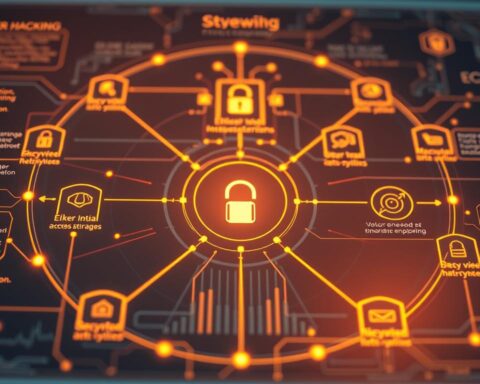Did you know cybercrime complaints soared to over 790,000 in 2020? This led to more than $4.1 billion in damages. This huge jump from $17.8 million in 2001 shows we need better cybersecurity fast1. Welcome to Day 21 of our Cybersecurity Training. We’ll explore ethical hacking and penetration testing from the attacker’s side to strengthen your defenses.
Cybersecurity threats are at an all-time high today. It’s vital for companies to stay one step ahead of attackers2. By thinking like a hacker, security experts can find weaknesses before bad guys do. This is key, given the U.S. cybersecurity market is set to hit $345.4 billion by 20262.
Learning about ethical hacking and penetration testing is essential. These skills are in high demand. With info security analyst jobs expected to grow by 31% from 2019 to 2029, you’ll find great career paths1. This training will give you the tools to see systems from an attacker’s view. You’ll learn to defend against cyber threats more effectively.
Key Takeaways:
- Cybercrime damages have increased significantly, stressing the need for strong security measures.
- Ethical hacking uses hacker methods to find system weaknesses.
- The U.S. cybersecurity market is growing fast and needs more people.
- Seeing things from an attacker’s perspective helps build better defenses.
- Jobs for info security analysts are expected to grow a lot in the future.
- Ethical hacking and penetration testing skills are very valuable today.
Understanding the Foundations of Ethical Hacking
Ethical hacking is key to keeping our digital world safe. Cybercrime is expected to cost $10.5 trillion by 2025. This makes skilled ethical hackers more important than ever3. They find weaknesses in networks before hackers can.
Defining Ethical Hacking vs. Malicious Hacking
Ethical hacking is legal and aims to find and fix security gaps. It’s different from malicious hacking, which is illegal and harmful4. Ethical hackers pretend to be hackers to find and fix weaknesses.
Legal and Ethical Considerations
Ethical hackers must follow strict rules. They need permission and keep secrets. The job market for info security analysts is growing fast, showing how vital ethical hacking is3.
Core Principles of Penetration Testing
Penetration testing is a main part of ethical hacking. It helps find and fix security issues. Companies that do this well can cut their risk of security breaches by 40%4. Most problems come from simple mistakes or outdated software4.
| Aspect | Ethical Hacking | Malicious Hacking |
|---|---|---|
| Intent | Improve security | Exploit vulnerabilities |
| Authorization | Legal consent | Unauthorized |
| Outcome | Enhanced protection | Potential data breach |
The market for penetration testing is growing fast, expected to hit $3.4 billion by 20284. Getting certified as a Certified Ethical Hacker (CEH) is becoming more important3.
Knowing these basics helps cybersecurity experts protect us from cyber threats. They can find and fix weaknesses in our networks.
Ethical Hacking and Penetration Testing: Gaining the Attacker’s Perspective
Ethical hacking is key in keeping our digital world safe. It lets experts think like hackers to find and fix threats before they happen. In 2023, hackers made off with $744 million online, showing we need to act fast5.
Most companies, 85%, use ethical hacking to keep their data safe6. This method finds and fixes weak spots before hackers can use them. Penetration testing, a big part of it, can cut data breach risks by 30%6.
- Reconnaissance
- Scanning
- Gaining Access
- Maintaining Access
- Clearing Track
This way of working is like real attacks, but it’s done right. It lets teams practice being hackers while staying on the right side of the law7.
Penetration tests are mainly three types:
- White Box: You know everything about the system
- Black Box: You know nothing
- Gray Box: You know a little
These tests show where a system is weak5.
Ethical hacking really makes a difference. It finds new problems 80% of the time. And 92% of companies say it makes them better at keeping their data safe6.
“Ethical hacking is not just about finding flaws; it’s about understanding the attacker’s perspective to build stronger defenses.”
By thinking like hackers, cybersecurity experts can keep up with threats. They can protect our digital world better.
Essential Tools and Technologies for Penetration Testing
Penetration testing is like a mock cyberattack to find weaknesses before real hackers do8. It needs a wide range of tools to check system security well. Let’s look at some key tools for penetration testing and ethical hacking.
Network Scanning Tools
Network scanning finds hosts and services. Nmap works on many systems like Linux, Windows, and BSD9. It’s great for finding and checking network security8.
Vulnerability Assessment Software
Vulnerability scanners like Nessus find system weaknesses8. Invicti scans websites and checks for OWASP Top 10 attacks9.
Exploitation Frameworks
The Metasploit framework has thousands of exploit modules9. It’s key for ethical hacking8. Burp Suite helps with web app security, making brute-forcing and fuzzing faster98.
Password Cracking Utilities
John the Ripper cracks passwords for 15 systems and spots weak ones98. Hashcat uses many methods, including MD5 and SHA9. These tools are key for checking password strength.
Knowing these tools well is key for deep security checks. They are the core of today’s penetration testing and ethical hacking. They help experts find and fix weaknesses.
Reconnaissance and Information Gathering Techniques
Reconnaissance and information gathering are key in ethical hacking. They help find network weaknesses and plan tests10.
Ethical hackers use both passive and active methods to get data. Passive gathering is done without touching the target. Active gathering involves direct interaction10.
The ethical hacking process has five steps: reconnaissance, enumeration, exploitation, post-exploitation, and clearing tracks. In the first step, hackers use open-source intelligence (OSINT) to find public info10.
Next, enumeration involves direct interaction with the system. It helps find specific weaknesses by listing devices and services11.
| Reconnaissance | Enumeration |
|---|---|
| Passive approach | Active approach |
| Gathers publicly available information | Interacts with target systems |
| Uses OSINT techniques | Maps devices and services |
| Minimal risk of detection | Higher risk of detection |
Companies that do regular ethical hacking and testing face fewer data breaches. This approach helps spot security threats early and fix weaknesses1011.
Learning these techniques helps cybersecurity experts understand their targets better. This knowledge makes security checks more effective, boosting a company’s cyber safety. Discover more about ethical hacking and penetration to stay on top in cybersecurity.
Advanced Penetration Testing Methodologies
Penetration testing is key to strong security checks. It mimics real attacks to find weak spots in systems, networks, and apps. Almost 90% of companies use these tests to boost their security12.
External Network Testing
External tests look for vulnerabilities that hackers from outside could use. It’s important because 80% of cyber attacks use known weaknesses that tests aim to find12. This way, companies can make their defenses stronger and lower the chance of being hacked.
Internal Network Assessment
Internal tests check security from inside the company’s systems. It’s essential because 45% of cyber attacks come from inside13. These tests find insider threats and weaknesses that could be used by hackers if they get inside.
Wireless Network Security Testing
Wireless networks face special security risks. Penetration testers check Wi-Fi for weak spots, like bad encryption. This is key as more companies use wireless for their work.
Web Application Testing
Testing web apps is a big part of penetration testing. About 60% of cyber attacks target web apps, so it’s very important12. Testers use tools and manual checks to find common problems like SQL injection.
| Testing Type | Focus Area | Key Benefits |
|---|---|---|
| External Network | Perimeter Security | Identifies remote attack vectors |
| Internal Network | Insider Threats | Assesses internal vulnerabilities |
| Wireless Network | Wi-Fi Security | Evaluates wireless-specific risks |
| Web Application | Application Layer | Uncovers web-based vulnerabilities |
Using these advanced testing methods, companies can greatly improve their security. Studies show regular tests can make incident response 75% faster12. With the global market for these services expected to hit $4 billion by 2027, their importance in cybersecurity is clear12.
Social Engineering and Human Factor Exploitation
Social engineering is a key part of ethical hacking and cybersecurity. It uses human psychology to get unauthorized access to sensitive info. Social engineering attacks cause 93% of successful data breaches. This shows how important it is to focus on human factors in security14.
Organizations face big risks from social engineering. Over 80% have faced such attacks in the last year, with phishing being the most common1415. The average cost of a data breach from social engineering is $4.35 million. This highlights the financial damage these threats can cause15.
Employee Vulnerability and Training
Employees are often the weakest link in cybersecurity. In tests, they click on phishing emails 30% of the time14. Sadly, 80% of people say they haven’t had enough training to spot social engineering tactics14.

Companies that regularly train their employees see a 70% drop in successful phishing attacks15. This shows how vital ongoing education is in fighting social engineering threats.
Penetration Testing and Risk Assessment
Ethical hacking often includes social engineering tests to check how vulnerable an organization is. But, 60% of companies don’t do social engineering tests in their regular checks14. Companies that do these tests can cut their risk of attacks by up to 50% through better awareness and training16.
| Social Engineering Attack Type | Success Rate in Test Environments | Mitigation Strategy |
|---|---|---|
| Phishing | 30% | Regular email security training |
| Tailgating | 70% | Physical security awareness |
| Quid pro quo | 50% | Strict verification procedures |
By adding social engineering tests to their cybersecurity plans, organizations can protect better against human weaknesses. This strengthens their overall security.
Vulnerability Assessment and Risk Analysis
It’s key to find network vulnerabilities and do security checks to protect digital stuff. Companies use different methods to spot weaknesses and manage risks well.
Identifying System Weaknesses
Vulnerability scanning is a big part of keeping systems safe. It’s done often to catch new threats fast17. Scans can take a few minutes to hours, depending on the network size. They’re good for all kinds of businesses17.
Penetration testing is like a mock attack. It gives deeper insights but takes more time and money17.
Prioritizing Security Risks
Regular tests help find and fix problems before they become big issues18. They find mistakes, coding errors, and other hidden problems. This makes systems more secure18.
The OWASP Top 10 lists major web app vulnerabilities like SQL injection and cross-site scripting19.
Documentation and Reporting
Scan reports show found weaknesses, sorted by how bad they are17. Penetration tests give detailed reports on how attacks could happen and what damage they could do17.
These reports help see if security is getting better over time19.
| Aspect | Vulnerability Scanning | Penetration Testing |
|---|---|---|
| Frequency | Daily/Weekly | Annually/Bi-annually |
| Duration | Minutes to Hours | Days to Weeks |
| Cost | Low | High |
| Depth | Broad Overview | Targeted, Detailed |
Using both scans and tests gives a full picture of security risks. This helps companies build strong defenses against cyber threats1719.
Defense Strategies and Countermeasures
In the world of cybersecurity, defending digital assets is key. Companies must be proactive to keep their networks safe from threats.
Network Hardening Techniques
Network hardening is a big part of keeping systems safe. It makes networks stronger against attacks. Regular tests help find weak spots in networks and systems20.
Doing these tests yearly helps keep security strong and lowers risks20.
Security Control Implementation
Putting in place strong security controls is important. Companies should use preventive, detective, and corrective steps. Firewalls and IPS/IDS are often targeted in tests20.
Fixing these issues is key to a secure environment.
Incident Response Planning
A good plan for handling security breaches is essential. The cost of a breach can be much higher than testing21. Using threat modeling and testing in software development helps find and fix problems early22.
In today’s world, Small and Medium-sized Businesses are often seen as easy targets for hackers21. Strong defense strategies are a must. A good cybersecurity plan helps protect a company’s reputation and keeps customers trusting them21.
Real-World Attack Scenarios and Case Studies
Ethical hacking and penetration testing show us how to protect our networks. They mimic real attacks to find weak spots. This helps companies fix their defenses before threats hit.
Some tests are done just to meet rules like CMMC or PCI DSS. They use tools like Nessus or OpenVAS23. But real tests use both tools and custom scripts for a deeper look23.
Structured tests are common, but real tests dive into unique situations. They find more vulnerabilities23. This detailed check costs more but shows a clearer picture of security23.
Cross-Site Scripting (XSS) Attacks
XSS attacks are a big risk for websites. Reflected XSS attacks happen in one request and response24. Persistent XSS attacks, the most dangerous, can harm systems for a long time24.
TikTok faced an XSS attack that let attackers control accounts. This shows why we need to see things from the attacker’s view. It helps us find and fix these problems better.
| XSS Attack Type | Characteristics | Potential Impact |
|---|---|---|
| Reflected XSS | Single HTTP request and response | Immediate, short-term compromise |
| Persistent XSS | Malicious script stored on target servers | Long-lasting, widespread impact |
| DOM-based XSS | Stealthy, difficult to detect server-side | Client-side manipulation, data theft |
Learning from these attacks helps us get ready for future threats. It shows how important ethical hacking and penetration testing are today.
Conclusion
Ethical hacking and penetration testing are key in today’s cybersecurity world. They help security experts see things from an attacker’s point of view. This way, they can find and fix weaknesses before hackers do.
Studies show that regular testing can cut the chance of a security breach by up to 50%. Also, 80% of companies say they can respond faster to incidents after testing25.
Ethical hacking uses many tools and methods to check an organization’s security. Scanners find about 70% of weaknesses, while tests find another 30% that hackers might use25. This complete approach is vital because cyber threats are getting more complex and common7.
The need for ethical hackers is growing fast. It’s expected that over 3 million jobs will be needed by 202525. This shows how important ethical hacking is for keeping our digital world safe.
By thinking like hackers and using the latest tools, cybersecurity experts can build strong defenses. This helps make the internet safer for everyone.
FAQ
What is the difference between ethical hacking and malicious hacking?
Why is it important to adopt the attacker’s perspective in cybersecurity?
What are some essential tools used in ethical hacking and penetration testing?
How does social engineering fit into ethical hacking?
What are the key steps in conducting a penetration test?
How can organizations benefit from ethical hacking?
What legal considerations should be taken into account when performing ethical hacking?
How often should penetration testing be conducted?
What is the role of vulnerability assessment in ethical hacking?
How can ethical hacking help in developing better defense strategies?
Source Links
- The Role of Ethical Hacking and Penetration Testing in Cybersecurity Education – https://peer.asee.org/the-role-of-ethical-hacking-and-penetration-testing-in-cybersecurity-education.pdf
- Ethical Hacking: A Beginner’s Guide | Institute of Data – https://www.institutedata.com/us/blog/ethical-hacking-a-beginners-guide/
- The Definitive Guide To Ethical Hacking – MyComputerCareer – https://www.mycomputercareer.edu/the-definitive-guide-to-ethical-hacking/
- Ethical Hacking – https://www.malwarebytes.com/cybersecurity/basics/what-is-ethical-hacking
- Introduction to Ethical Hacking and Penetration Testing – https://online.yu.edu/katz/blog/ethical-hacking-and-penetration-testing
- What’s the Difference Between Penetration Testing And Ethical Hacking? – https://www.pentestpeople.com/blog-posts/whats-the-difference-between-penetration-testing-and-ethical-hacking
- Ethical Hacking and Penetration Testing – https://www.ijraset.com/research-paper/ethical-hacking-and-penetration-testing
- Getting Started with Penetration Testing: Essential Tools and Techniques – https://medium.com/@zerodayfreak/getting-started-with-penetration-testing-essential-tools-and-techniques-2bc2c0fe4aa4
- 7 Pentesting Tools You Must Know About – https://www.hackerone.com/knowledge-center/7-pentesting-tools-you-must-know-about
- PDF – https://papers.academic-conferences.org/index.php/eccws/article/download/1438/1148
- Ethical Hacking vs Penetration Testing | Indusface Blog – https://www.indusface.com/blog/how-penetration-testing-is-different-from-ethical-hacking/
- What is Penetration Testing? A Comprehensive Guide – https://networkats.com/penetration-testing-guide/
- Mastering Digital Defense: A Comprehensive Guide to Ethical Hacking and Penetration Testing for… – https://cyberarafat.medium.com/mastering-digital-defense-a-comprehensive-guide-to-ethical-hacking-and-penetration-testing-for-e933afeecb44
- The Role of Social Engineering in Penetration Testing – https://www.linkedin.com/pulse/role-social-engineering-penetration-testing-cloudmatos-jzxec
- Article 8: Social Engineering in Ethical Hacking: Understanding and Mitigating Human Risks – https://medium.com/@teja.ravi474/article-8-social-engineering-in-ethical-hacking-understanding-and-mitigating-human-risks-1f8520cca4c9
- A Comprehensive Guide to Penetration Testing – Types, Methods, Benefits and Best Practices – https://ermprotect.com/blog/a-comprehensive-guide-to-penetration-testing/
- The Role of Vulnerability Scanning and Penetration Testing – https://www.linkedin.com/pulse/role-vulnerability-scanning-penetration-testing-ron-sharon-famfc
- What is Penetration Testing? The Role of Pen Testing in Cybersecurity | CyberMaxx – https://www.cybermaxx.com/resources/what-is-penetration-testing/
- Penetration Testing vs. Vulnerability Assessments: Key Differences – Vivitec – https://vivitec.net/what-is-the-difference-between-penetration-testing-and-vulnerability-assessment/
- What Are The Different Types Of Penetration Testing? – https://purplesec.us/learn/types-penetration-testing/
- Intersec website – https://www.intersecinc.com/guides/comprehensive-guide-to-penetration-testing
- Getting a Pentest? Try a Threat Model first! | CMS Information Security & Privacy Group – https://security.cms.gov/posts/getting-pentest-try-threat-model-first
- Check-the-box Penetration Test vs. Real-World Penetration Testing – https://petronellatech.com/blog/check-the-box-penetration-test-vs-real-world-penetration-testing/
- 10 Practical scenarios for XSS attacks – https://pentest-tools.com/blog/xss-attacks-practical-scenarios
- Ethical Hacking vs. Pen Testing Differences – Blue Goat Cyber – https://bluegoatcyber.com/blog/ethical-hacking-vs-pen-testing-differences/










